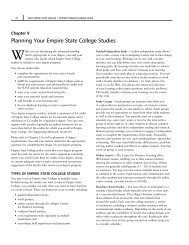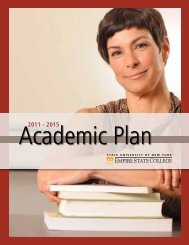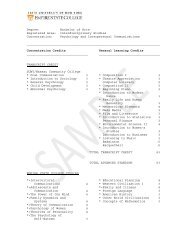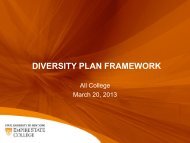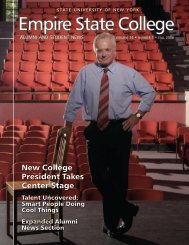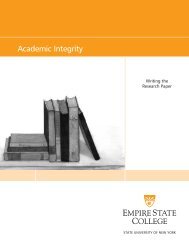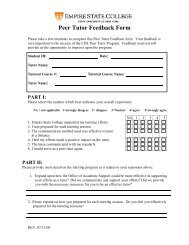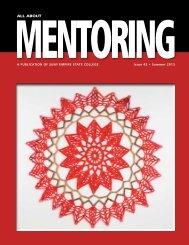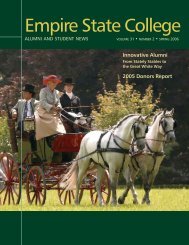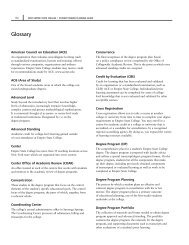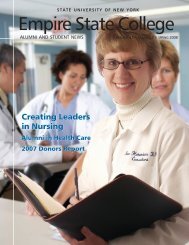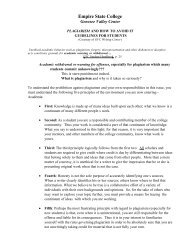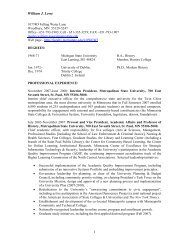All About Mentoring Spring 2011 - SUNY Empire State College
All About Mentoring Spring 2011 - SUNY Empire State College
All About Mentoring Spring 2011 - SUNY Empire State College
You also want an ePaper? Increase the reach of your titles
YUMPU automatically turns print PDFs into web optimized ePapers that Google loves.
70<br />
through various modes, including these<br />
convergent mobile devices that fit in the<br />
palms of our hands and can be used for<br />
making the occasional phone call. Today’s<br />
mobility continues to be a way to express<br />
openness and freedom propelled forward by<br />
a youthful sense of innovative app design<br />
and use.<br />
Based on the report Mobile Access 2010<br />
(Smith, 2010), conducted by The Pew<br />
Internet and American Life Project,<br />
“Fifty-nine percent of adults now access<br />
the Internet wirelessly using a laptop or<br />
cell phone”(p. 1). This is a significant trend,<br />
but perhaps of most importance is what<br />
people are doing with these devices. This is<br />
a new era for creative freedom, as mobility<br />
allows for taking and exchanging pictures<br />
and videos, sending and receiving text<br />
messages, playing games and downloading<br />
music. Individual activities become<br />
collaborative actions through linking and<br />
interacting with others and by sharing<br />
and participating within an expansive<br />
collaborative network. The <strong>2011</strong> Horizon<br />
Report identified mobile computing as<br />
one of the key trends in higher education,<br />
asserting that: “mobiles are capable<br />
computing devices in their own right – and<br />
they are increasingly a user’s first choice for<br />
Internet access” (p. 5). This report suggests<br />
that the learner is an active, collaborative<br />
and interactive participant, and mobile<br />
devices provide easy access to the Internet<br />
for communication and for the creation of<br />
individual and collaborative documents.<br />
Open Mobile Learning<br />
As an emerging trend in higher education,<br />
mobile learning is an area for scholarly<br />
exploration and for collaborative practice<br />
in face-to-face and online environments.<br />
The relationship between open and mobile<br />
learning has been examined in a special<br />
edition of Open Learning (2010). This<br />
issue features several essays that report on<br />
innovations taking place internationally,<br />
including: The Open University, UK; The<br />
University of South Africa, Pretoria, South<br />
Africa; and The University of Waikato,<br />
Hamilton, New Zealand. As <strong>Empire</strong> <strong>State</strong><br />
<strong>College</strong> rediscovers its own 40-year legacy as<br />
an open institution, it is useful for us to see<br />
how instructors and researchers are engaging<br />
with trends in mobile learning. The essays<br />
in this volume also remind us how much<br />
technology has transformed in the past 40<br />
years and how we must continuously adapt<br />
to these changes. According to guest editor<br />
Agnes Kukulska-Hulme, “with its strong<br />
emphasis on learning rather than teaching,<br />
mobile learning challenges educators to try<br />
to understand learners’ needs, circumstances<br />
and abilities even better than before”<br />
(p. 18). As this journal suggests, mobile<br />
learning opens education to students with<br />
access to a range of portable devices and<br />
to international audiences with immediate<br />
access to cell phones.<br />
According to Kukulska-Hulme, mobile<br />
learning is complementary to current<br />
technologies and does not automatically<br />
replace other formats such as “desktop<br />
computers, pen, paper and printed books”<br />
(p. 184). She envisions the mobile device<br />
as a way to support learning in between<br />
classroom sessions, and as a means to<br />
explore both formal and informal learning.<br />
In addition, Kukulska-Hulme clearly<br />
identified the way mobility opens education<br />
to a wider audience. She argued that:<br />
“learning is open to all when it is inclusive,<br />
and mobile technologies are a powerful<br />
means of opening learning to all those who<br />
might otherwise remain at the margins of<br />
education” (p. 184). She sees the mobile<br />
device as a way to engage learners who may<br />
have previously been unable to experience<br />
traditional modes of learning. Further, she<br />
argued that mobility has the potential to<br />
bring education to international audiences<br />
and “to girls and women, who, in many<br />
parts of the world, are still denied basic<br />
opportunities to improve their lives through<br />
education” (p. 184-185). This ambitious and<br />
inclusive method for open mobile learning<br />
continues with several research essays that<br />
further support the value of this approach.<br />
Netbooks<br />
Mobility extends beyond the smart phone<br />
and includes such devices as the netbook.<br />
A team of researchers (Gaved et. al.,<br />
2010) at The Open University conducted<br />
a study of netbook use that included over<br />
300 secondary school students and seven<br />
teachers during seven trials (p. 187). The<br />
purpose of this study was to determine<br />
“how well the netbooks performed as<br />
mobile learning devices for education”<br />
(p. 188). The context for these open<br />
learners included a combination of formal<br />
and informal environments such as the<br />
classroom, fieldwork locations and home<br />
(p. 196). According to this study, “netbooks<br />
were ideal as lightweight, portable devices<br />
for use in the field, capable of running<br />
multiple software programs to transmit<br />
video and audio and to store high-resolution<br />
images” (p. 197). The netbooks also offered<br />
extended battery life which worked well in a<br />
variety of field locations, allowing students<br />
the flexibility to complete several tasks<br />
at times that were convenient for them.<br />
The authors recommended the netbook<br />
as an option for distance learners because<br />
the devices are “highly portable,” flexible<br />
and open to multiple inputs (p. 198). The<br />
netbooks also featured highly usable screens<br />
that allowed for a range of activities, from<br />
writing to browsing the Web. The study<br />
found that students considered the hardware<br />
to be intuitive because of their previous<br />
familiarity with the netbook functionality,<br />
and the network connections allowed for<br />
easy access to a range of online resources.<br />
Although the researchers are interested in<br />
comparing the netbooks to smart phones, it<br />
is clear that netbooks offered flexibility and<br />
functionality to open and distance learners.<br />
Mobile Media Players (iPods and<br />
MP3 players)<br />
The potential for mobile media players<br />
such as the Apple iPod was examined by<br />
a team of researchers from the School of<br />
Education at The Open University, UK.<br />
Shohel and Power (2010) examined the<br />
use of mobile technologies to improve<br />
English-language instruction in Bangladesh.<br />
The authors conducted a study of open<br />
distance learning based on interviews with<br />
teachers who participated in a professional<br />
development English in Action (EIA)<br />
program. Within this framework, “Englishlanguage<br />
teachers are provided with media<br />
players (iPods), preloaded with video and<br />
audio language learning resources, along<br />
with battery-powered speakers for use<br />
in the classroom” (p. 204). Based on the<br />
analysis of interviews, the authors found<br />
that “the use of new mobile technology has<br />
been shown to facilitate access to learning,<br />
as well as improve the quality of teacher<br />
education and training” (p. 213). The use<br />
suny empire state college • all about mentoring • issue 39 • spring <strong>2011</strong>




